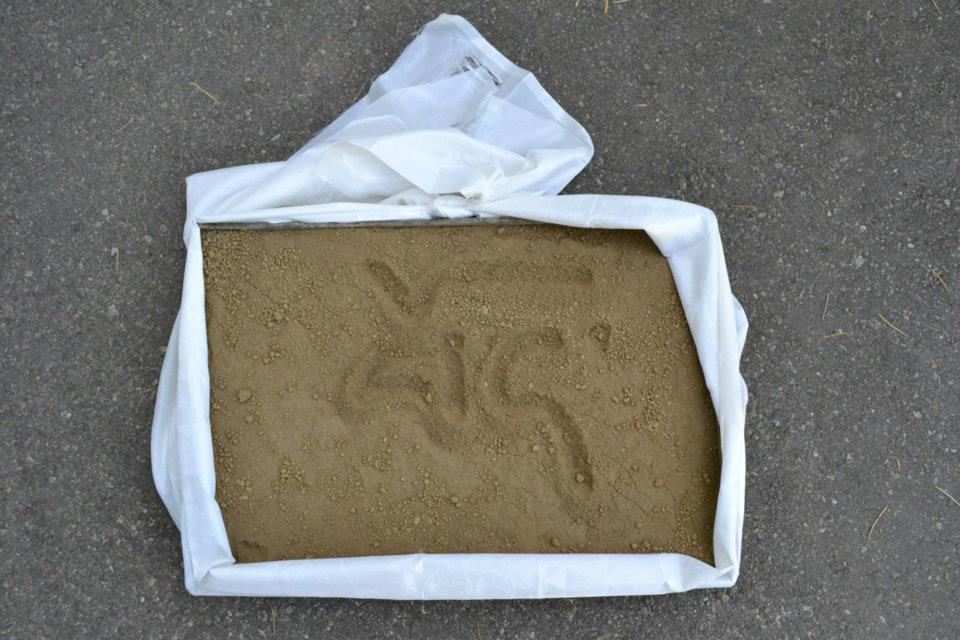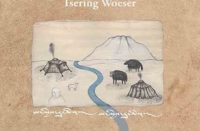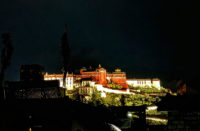High Peaks Pure Earth has translated a blogpost by Woeser written on November 1, 2011 for the Tibetan service of Radio Free Asia and posted on her blog on November 7, 2011.
This post is about a Tibetan artist Tenzing Rogdol’s art installation that took place in Dharamsala in October 2011 and at the time garnered much media attention, see these news reports on CNN and Wall Street Journal’s China Real Time Report.
For Woeser’s previous posting about the contemporary Tibetan art exhibition in Beijing, see this post titled Those Giving Voice to the Scorching Sun of Tibet.



“Tibet” is a Mark Deeply Impressed on Our Foreheads
and in Our Hearts
By Woeser
A Tibetan artist did an extraordinary thing, he took the risk to fetch and distribute from inside silent and tightly controlled Tibet, 20 tons of his homeland’s soil. He is the young 29 year old exiled Tibetan, Tenzing Rigdol.
When I saw his photo on an Indian media website, I remembered that the modern Tibetan art exhibition held in Beijing in the Autumn two years previously under the title “Scorching Sun of Tibet” had exhibited some of his works, comprising his portrait and a collection of drawings covered with Tibetan script; they left a deep impression on me. I muttered to my friend who I was with at the exhibition that probably only very few people would know what kind of book the artist on the picture was holding in his hands. But we of course recognised at once that what he was holding was the works of His Holiness the Dalai Lama. Of course, the face of His Holiness had been thoroughly covered up by the artist, otherwise it would not have been allowed at an exhibition in Beijing.
One year later, Tenzing Rigdol created a new work of art of astonishing imagination and perseverance; he curated an exhibition in the heart of the Tibetan exile community, in Dharamsala, titled “Our Land, Our People”. The home soil comforted countless exiled Tibetans, including the elderly who had left their homes over 50 years ago, the youngsters who had crossed the snow mountains to escape the gun muzzles as well as the middle-aged people who had been born abroad and never set foot in their home country; with hot tears in their eyes, they worshipped the portrait of His Holiness, offered khatas to the “Tibetan Soil” on the Tibetan flag and prostrated; finally, they walked on the soil that had been brought back from home, some also took up a handful of soil as if they were able to espy their homeland. In this way, the artist and the visitors together completed this epic-like artwork.
Particularly memorable was the participation of His Holiness the Dalai Lama. During the organisation of the exhibition, Tenzing Rigdol had an audience with His Holiness and offered some homeland soil; on the spot, His Holiness used his fingers and wrote the Tibetan letters for “Tibet” into the soil. This was the soil which His Holiness has been separated from for 52 years and even though it was only packed in a small box, which one could not even set foot on, it was of auspicious origins and signified a future return and thus gave 6 million Tibetans a vision to one day be united with His Holiness on Tibetan grounds.
The Radio Free Asia journalist Dolkar La interviewed the artist Tenzing Rigdol. While listening to it, I went through a surge of emotions, repeatedly brimming over with warm tears of excitement. At the exhibition, the exiled Tibetans who had suffered from being separated from their homeland could pour out their feelings in front of their homeland soil. The words of a young person deeply moved me, he said in a choking voice: “The karmaless me who was born in exile and who had never seen the soil of his homeland, finally got the chance to see it today.” I told this sentence to Wang Lixiong who responded by stating a different fact: “although being exiled is sad, but exiled people also have karma because they can meet the Dalai Lama, they are together with the Dalai Lama who is equally in exile.”
This sentence suddenly made me realise my own plight. I remembered a long conversation I had with some Khampa Tibetans in Chengdu at the beginning of last year; they were all civil servants, teachers etc. and came to speak of the fact that up to the present day it had been impossible to apply for a passport, and that it is thus equally impossible to realise the dream to meet His Holiness. Later I asked what would happen if one day His Holiness was no longer there? I should not have said these words, they sat there with their heads low and when they raised their heads, their faces were all covered in tears, “we have already lost all our karma, Buddhas and Bodhisattvas will show solicitude for us, should not let us have lifelong regrets”, “if this day comes, and if His Holiness still cannot come back, then we will stand up, and if even people like us stand up, then many Tibetans all across the Tibetan region will be burning with rage”.
Finally, Tibetans inside and outside Tibet all endure the same suffering, even if they live on their own soil, they are not the masters of their own soil, they have all lost their homeland. However, the word “Tibet” which His Holiness wrote into the “Tibetan soil” is a mark deeply impressed on our foreheads and in our hearts; we will never ever forget the name of this piece of soil, it is “Tibet”.
Beijing, November 1, 2011





Follow Us!